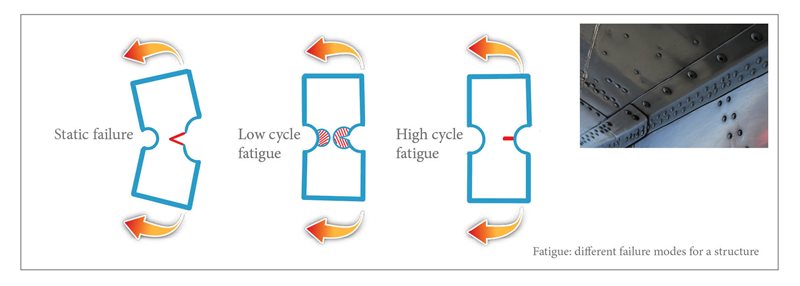Airframe Structure Analysis for Engine Integration
Obviously, one of the most crucial factors in safe flight is airframe structural integrity. The structure of an airframe is responsible for holding everything in place, and more importantly, in one piece. When it comes to integrating an engine into the structure of an airframe, there are three primary areas of concern we must analyze: the local strength of the structure, the elasticity of the structure, and cyclic fatiguing of the structure.
Local strength refers to the stress capacity, or ability to take on loads, of specified points on structural members. A trained eye would know which points to look for and what types of stress failure are likely to occur at these points. If an engine is attached to an airframe via several long, narrow structural members, then all of these members must be analyzed for bending failure. If an engine is attached to as small part of a large structural member, then this small part of the member should be analyzed for shear failure or crack propagation.
Elasticity and deformation are two key concepts to consider ensuring that the engine remains where it is supposed to be relative to the airframe. First, we must define two types of deformation. Elastic Deformation occurs when a material is only mildly deformed and will return to its normal shape once unloaded. Inelastic (or plastic) deformation occurs when a material is deformed beyond the elastic range, and once unloaded, will return to a shape that is offset from the original one of the material. It is important to ensure that inelastic deformation never occurs on an airframe due to engine thrust loads. Alongside this, the amount of elastic deformation caused by engine thrust loads must also be considered. Depending on the surrounding structural members, elasticity in the airframe could lead to the engine to pivot slightly, facing off-axis, or even damage surrounding components.

Finally, fatiguing of the structure might be the most important consideration, as it is one that is not easily noticed until failure occurs. All common metals experience a phenomenon called cyclic fatiguing, where the more times a material is loaded and unloaded, the weaker the strength of the material becomes. For steel, a structural member will decrease in strength constantly until approximately 10 million cycles. At this point the steel has reached its fatigue limit and will not decrease in strength any further regardless how many times it is loaded. Most airframe structures are constructed from aluminum, as the material is light and easy to work with. Aluminum, in contrast does not have a fatigue limit. As aluminum is cycled more times, the rate at which it fatigues will slow, but never stop. If cycled enough times the strength of an aluminum structure will go to zero.
So far, I have presented three problems for engine integration but no solution to these. Sure, there are equations that correlate to these problems that can be used to solve them, but with complex structures such as an airframe, engineers typically opt to involve software in the design process. Finite Element Analysis is the theory and corresponding simulation software that allows structural engineers to rapidly calculate each of these different problems and make informed design decisions relating to those results. Everything from stress and strain to fatigue data can be determined in a single, well-designed simulation.
Though PBS cannot assist in designing the airframe structure, our engineers can provide assistance in diagnosing issues with the engine relating to the airframe. If you have any other questions about the integrating of our engines, contact us at
info@pbsaerospace.com. One of our engineers would be happy to help you.
